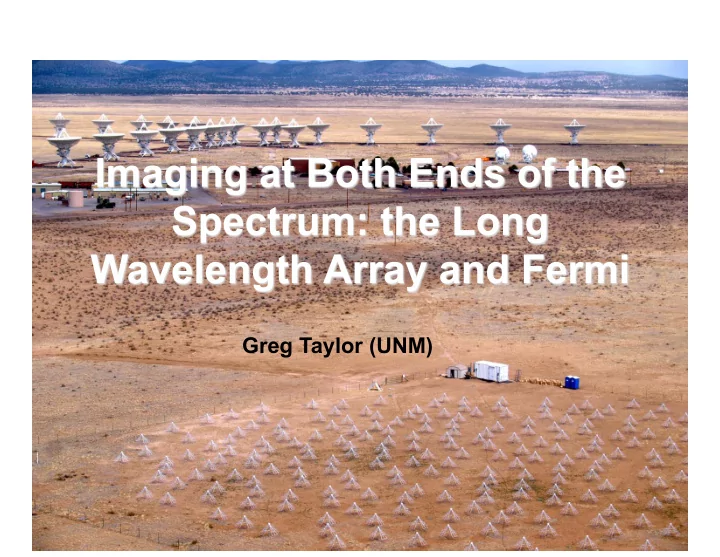

Greg Taylor (UNM)
The LWA Instrument • 10-88 MHz Aperture Synthesis Telescope • 4 beams x 2 pol. x 2 tunings x 16 MHz • 2 all-sky transient obs. modes LWA-1 State of New Mexico, USA • LWA-1 completed Spring 2011 • Goal of 53 LWA stations, baselines up to 400 km for resolution 2” at 80 MHz with mJy sensitivity • Cost is ~$1M/station
LWA1 Title 10-88 MHz usable Galactic noise-dominated (>4:1) 24-87 MHz 4 independent beams x 2 pol. X 2 tunings each ~16 MHz bandwidth SEFD ~ 3 kJy (zenith) S min ~ 5 Jy (5 σ , 1 s, 16 MHz, zenith) All sky (all dipoles) modes: TBN (67 kHz-bandwidth; continuous) TBW (78 MHz-bandwidth, 61 ms burst) One “outrigger” antenna ~300 m to the East LWA1 science emphasis: transients, pulsars, Sun, Jupiter & Ionosphere 3 Open skies
1 day 10 50 90 MHz 4
5
Digital Processor (DP) Analog Signal Processor (ASP) 6
Highlights - 1 Images 10 sec 50 kHz 7
Cygnus A Drift Scan Cygnus A drifts through a beam at 74 MHz 10/6/2011 1.2 MHz bandwidth 220 dipoles No RFI excision Time (seconds) 8
Multi-beaming Cyg A: 295.0 az., 49.5 el. Cas A: 0.0 az., 65.2 el. 9
Comparison to other instruments Declination Range Δν (MHz) UTR2: -30 ° to +60 ° 33 LOFAR: -11 ° to +90 ° 3.6 Y=VLA:-35 ° to +90 ° 3 LWA1: -30 ° to +90 ° 16 GMRT: -53 ° to +90 ° 10 LWA1 has sensitivity comparable to all of LOFAR 10
Pulsar 38 MHz 11
Steep Spectrum Pulsars and Connection to Fermi • Before 2008, Geminga was the only known radio-quiet gamma-ray pulsar • Blind searches of Fermi LAT data have discovered over 36 pulsars in the gamma- ray band! • So far, only 4 have Is this a beaming effect or some other physical been found to pulse in mechanism? • radio, despite very Low frequency searches are promising because deep searches beaming fractions appear to increase • Some pulsars appear to be very steep spectrum (S ~ ν –4 )
LWA1 Science Overview Key LWA Science Drivers (LWA1 subset in red) • Acceleration of Relativistic Particles in: • Hundreds of supernova remnants in normal galaxies at energies up to 10 15 eV • Thousands of radio galaxies & clusters at energies up to 10 19 eV • Ultra-high energetic cosmic rays at energies up to 10 21 ev and beyond • Cosmic Evolution & the High Redshift Universe • Evolution of Dark Matter & Energy by differentiating relaxed and merging clusters • Study of the 1st black holes & the search for HI during the EOR & beyond • Plasma Astrophysics & Space Science • Ionospheric Waves & Turbulence • Acceleration, Turbulence, & Propagation in the ISM of Milky Way & normal galaxies • Solar, Planetary, & Space Weather Science • Transient Universe • Possible new classes of sources (coherent transients like GCRT J1745-3009) • Magnetar Giant Flares • Extrasolar planets • Prompt emission from gamma ray bursts (GRBs) • LWA1 will do excellent science from the transformational to the modest – Both extremes represent excellent science, serendipitous discoveries likely, viable student thesis projects – made possible because LWA1 is BIG! 13
• A backend to the LWA1 ’ s digital processor • Receives the TBN data stream: continuous 100 kSPS data from all the dipoles • Using a software FX correlator, PASI images most of the sky ( ≈ 1.5 π sr) many times per minute at 100% duty cycle • This is a virtually unexplored region of transient phase space! (radio frequency, sky coverage, imaging cadence, uptime)
Transients that are BRIGHT and RARE: • Bright flares from Hot Jupiters • Giant flares from magnetars • Prompt GRB emission • The unknown … Bower et al. (B07, B10), Banister et al. (BA10), Croft et al. (C10), Frail et al. (F03), Gal-Yam et al. Strategy for candidate detections: (G06), Lazio et al. (L10) • Automatic follow-up with an LWA1 beam: raster scanning over the candidate transient ’ s location • Ultimately, confirmed detections will trigger rapid alerts for multi-wavelength follow-up
Summary LWA1 is an operational, world-class instrument There are many opportunities for discovery: pulsars, transients, cosmology… LWA1 is an early example of a large N array – 32,640 baselines Images of the sky are available 24/7 on LWA TV http://www.phys.unm.edu/~lwa/lwatv.html 17
Backup Slides
Hallinan et al. (2008) Flux density (Jy) Frequency (MHz) • Low frequency (only) • Highly polarized • Time-variable emission: + Only present during (small) subset of rotational phase + Bursty on ~ms to ~min time scales
• Confusion limit is 25 Jy/beam at 74 MHz, but this limit is dominated by constant sources • Search strategies: + Image differencing (good to 10% ⇒ 2.5 Jy limit) + Polarization filtering (potentially much better; ~30 dB isolation) • Noise limits for 74 MHz frequency, 80 kHz bandwidth — 10 s integration: 2 Jy/beam 2 hr integration: 100 mJy/beam • Few comparable studies: Lazio LWDA prototype transient search (106 hr) et al. had a noise level of 500 Jy/beam (2010)
Recommend
More recommend